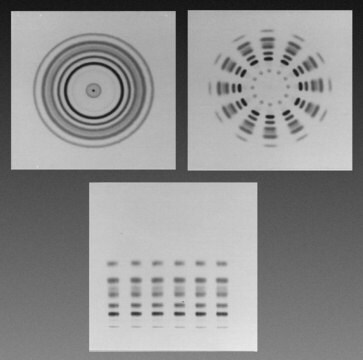1.05728
TLC plates, Cellulose F
pkg of 50 plates, plate L × W 20 cm × 10 cm, glass support
Sinónimos:
Cellulose Thin Layer Chromatography Plates
Iniciar sesiónpara Ver la Fijación de precios por contrato y de la organización
About This Item
UNSPSC Code:
41115711
NACRES:
NB.21
Productos recomendados
material
cellulose matrix
glass support
Quality Level
feature
binder Organic Polymer
fluorescent indicator
packaging
pkg of 50 plates
technique(s)
thin layer chromatography (TLC): suitable
layer thickness
80-120 μm
plate L × W
20 cm × 10 cm
storage temp.
2-30°C
Categorías relacionadas
General description
50 Glass plates 10 x 20 cm
Our cellulose plates are used to analyze polar substances. An organic sorbent, cellulose is perfect for separating hydrophilic substances by partition chromatography. Typical applications include the analysis of amino acids, carbohydrates, and phosphates as well as nucleic acid and nucleic acid derivatives. We offers cellulose plates in two grades: TLC for conventional and HPTLC for demanding, high-performance separations.
Linkage
Replaces: 5728-6; 5728
Analysis Note
Layer thickness: 80 - 120 µm
Deviation of layer thickness per plate: ≤ 30 µm
Aminoacid test
hRf-values
- L-serine, amino acid test:
20 - 30
- L-threonine, amino acid test: 29 - 36
- L-alanine, amino acid test: 30 - 40
- L-methionine, amino acid test: 49 - 60
- L-phenylalanine, amino acid test: 59 - 70
- L-leucine, amino acid test: 66 - 76
Typical value determined on a plate
Eluent: 1-Butanol/ acetone/ acetic acid/ water (35/35/7/23 v/v/v/v) twice developed
Deviation of layer thickness per plate: ≤ 30 µm
Aminoacid test
hRf-values
- L-serine, amino acid test:
20 - 30
- L-threonine, amino acid test: 29 - 36
- L-alanine, amino acid test: 30 - 40
- L-methionine, amino acid test: 49 - 60
- L-phenylalanine, amino acid test: 59 - 70
- L-leucine, amino acid test: 66 - 76
Typical value determined on a plate
Eluent: 1-Butanol/ acetone/ acetic acid/ water (35/35/7/23 v/v/v/v) twice developed
Certificados de análisis (COA)
Busque Certificados de análisis (COA) introduciendo el número de lote del producto. Los números de lote se encuentran en la etiqueta del producto después de las palabras «Lot» o «Batch»
¿Ya tiene este producto?
Encuentre la documentación para los productos que ha comprado recientemente en la Biblioteca de documentos.
Nuestro equipo de científicos tiene experiencia en todas las áreas de investigación: Ciencias de la vida, Ciencia de los materiales, Síntesis química, Cromatografía, Analítica y muchas otras.
Póngase en contacto con el Servicio técnico